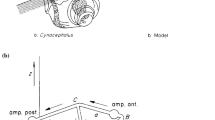Abstract.
A morphologically descriptive mathematical model was developed to study the role of labyrinthine geometry in determining sensitivities of each semicircular canal to angular motion stimuli in three-dimensional (3D) space. For this, equations describing viscous flow of the endolymph and poro-elastic response of the cupulae were coupled together and solved within a 3D reconstructed geometry. Results predict the existence of prime rotational directions about which the labyrinth resolves 3D angular movements into separate vectorial components. The components are predicted to be transmitted to the brain separately, one coded by each canal nerve. Prime directions predicted by the model are non-orthogonal, distinct from the anatomical canal planes, and distinct from the directions of rotation which elicit maximal responses of individual canal nerves. They occur for each canal along the intersection of the two null planes defined by its sister canals. Hence, rotation about a prime direction excites only one canal nerve. This contrasts the situation for rotations about anatomical canal planes, or about maximal response directions, where the model predicts activation of multiple canal nerves. The prime directions are sensitive to labyrinthine morphology and, hence, are predicted to vary between species and, to a lesser extent, vary between individual animals. Prime directions were estimated in the present work using a mathematical model, but could be determined experimentally based on the directional sensitivities of individual canal nerves. The model also predicts the existence of dominant eigenmodes and time constants associated with rotation in each of the prime directions. Results may have implications regarding the central representation of angular head movements in space as well as the neuronal mappings between three-canal afferent inputs and motor outputs.
Similar content being viewed by others
Author information
Authors and Affiliations
Additional information
Received: 26 January 1998 / Accepted in revised form: 26 January 1999
Rights and permissions
About this article
Cite this article
Rabbitt, R. Directional coding of three-dimensional movements by the vestibular semicircular canals. Biol Cybern 80, 417–431 (1999). https://doi.org/10.1007/s004220050536
Issue Date:
DOI: https://doi.org/10.1007/s004220050536




